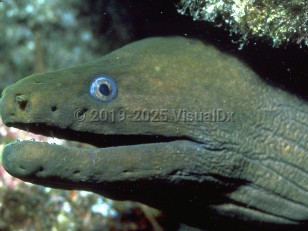Moray eels are bottom dwellers that inhabit tropical and subtropical coral reefs throughout the world where they are commonly found in holes and crevices. They are feared by many because of their snake-like appearance, bead-like eyes, and open mouths that seem ready to bite. In reality, moray eels rarely attack without provocation, have poor eyesight, and their mouths are open to allow water to pass through their gills to extract oxygen. Moray eels grow up to 3.5 m (11.5 ft) in length and 35 cm (1 ft) in diameter, and they can weigh up to 34 kg (75 lbs). They have vice-like, muscular jaws that can clamp down with great power and tear flesh from its prey.
Moray eels may bite defensively when their territory is intruded upon or if caught. Attacks have occurred when divers wave their hands in front of the eels, when the eel is speared, or in open water if eels have been fed by and associate humans with food. Moray eels have bitten surfers dangling their hands or feet over their boards.
The bite of a moray eel can cause deep puncture wounds or lacerations with tissue loss and ragged edges. There can be profuse bleeding. Occasionally, the eel might clamp down and not let go, necessitating the decapitation of the eel or breaking its jaws.
Bacterial contamination of wounds with marine pathogens such as Vibrio and Aeromonas is common.
Moray eel bite
Alerts and Notices
Important News & Links
Synopsis

Codes
ICD10CM:
W56.51XA – Bitten by other fish, initial encounter
SNOMEDCT:
217702009 – Moray eel bite
W56.51XA – Bitten by other fish, initial encounter
SNOMEDCT:
217702009 – Moray eel bite
Look For
Subscription Required
Diagnostic Pearls
Subscription Required
Differential Diagnosis & Pitfalls

To perform a comparison, select diagnoses from the classic differential
Subscription Required
Best Tests
Subscription Required
Management Pearls
Subscription Required
Therapy
Subscription Required
References
Subscription Required
Last Updated:10/18/2017

